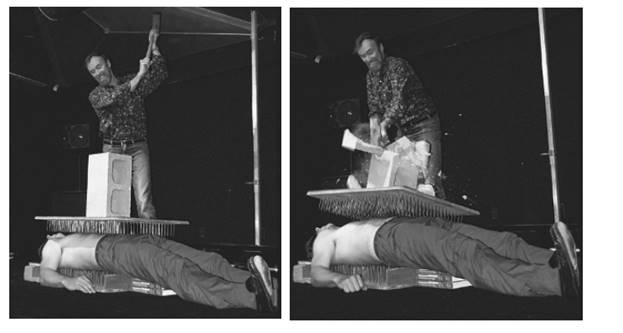
Concept explainers
Why is it important that many nails are in the boards of Figure 6.7?
To explain: The reason for so many nails in the board.
Explanation of Solution
Introduction:
Pressure is force per unit area. Pressure is inversely proportional to area.
Consider the figure shown below.

For constant force, pressure is decreased by increasing the surface area in contact.
On board, many nails are there so the pressure is reduced or decreased. Since the pressure is reduced, so the force applied on nail will not be enough to rupture the skin.
Thus, it is important to have many nails on the board.
Chapter 6 Solutions
Conceptual Physics C2009 Guided Reading & Study Workbook Se
Additional Science Textbook Solutions
Campbell Biology: Concepts & Connections (9th Edition)
Chemistry: An Introduction to General, Organic, and Biological Chemistry (13th Edition)
Human Anatomy & Physiology (2nd Edition)
Chemistry & Chemical Reactivity
Organic Chemistry (8th Edition)
Applications and Investigations in Earth Science (9th Edition)
- Please don't use Chatgpt will upvote and give handwritten solutionarrow_forwardNo chatgpt pls will upvote Already got wrong chatgpt answerarrow_forwardAn electron and a proton are each accelerated through a potential difference of 21.0 million volts. Find the momentum (in MeV/c) and the kinetic energy (in MeV) of each, and compare with the results of using the classical formulas. Momentum (MeV/c) relativistic classical electron proton Kinetic Energy (MeV)arrow_forward
- Four capacitors are connected as shown in the figure below. (Let C = 20.0 µF.) (a) Find the equivalent capacitance between points a and b. µF (b) Calculate the charge on each capacitor, taking ΔVab = 14.0 V. 20.0 µF capacitor µC 6.00 µF capacitor µC 3.00 µF capacitor µC capacitor C µCarrow_forward11. At what point in SHM is the velocity maximum? Displacement maximum?arrow_forward10. Why does the actual pendulum's plot of angle vs time flatten out at very large swing angles? Give a clear physical explanation.arrow_forward
- In the circuit shown below & = 66.0 V, R5 = 4.00, R3 = 2.00, R₂ = 2.20 ₪, I5 = 11.41 A, I₁ = 10.17 A, and i̟ = 6.88 A. Find the current through R2 and R3, and the values of the resistors R₁ and R. (Due to the nature of this problem, do not use rounded intermediate values-including answers submitted in WebAssign-in your calculations.) 12 = 8.12 8.12 13 R₁₁ = RA = A Based on the known variables, which two junctions should you consider to find the current I3? A 6.9965 61.5123 Ω Which loop will give you an equation with just R4 as the unknown? Did you follow the sign convention for the potential difference across each element in the loop? R₁ www 11 R₂ www R4 www 14 8 15 www R5 www R3arrow_forwardA car traveling at 42 km/h hits a bridge abutment. A passenger in the car moves forward a distance of 53 cm (with respect to the road) while being brought to rest by an inflated air bag. What magnitude of force (assumed constant) acts on the passenger's upper torso, which has a mass of 43 kg? Number i Unitsarrow_forwardThree resistors R₁ = 88.1 Q, R2 = 19.9 £2, R3 = 70.00, and two batteries & ₁ = 40.0 V, and ε2 = 353 V are connected as shown in the diagram below. R₁ www E₁ E2 R₂ ww ww R3 (a) What current flows through R₁, R2, and R3? 11 = 0.454 Did you choose directions for each of the three currents? Given that you have three unknowns to solve for, how many equations, at the least, will you need? A 12 = 1.759 Did you choose directions for each of the three currents? Given that you have three unknowns to solve for, how many equations, at the least, will you need? A 13 2.213 = Did you choose directions for each of the three currents? Given that you have three unknowns to solve for, how many equations, at the least, will you need? A (b) What is the absolute value of the potential difference across R1, R2, and R3? |AVR1 = 40.0 How is the potential difference related to the current and the resistance? V |AVR2 = 35.0 How is the potential difference related to the current and the resistance? V |AVR3 =…arrow_forward
 College PhysicsPhysicsISBN:9781305952300Author:Raymond A. Serway, Chris VuillePublisher:Cengage Learning
College PhysicsPhysicsISBN:9781305952300Author:Raymond A. Serway, Chris VuillePublisher:Cengage Learning University Physics (14th Edition)PhysicsISBN:9780133969290Author:Hugh D. Young, Roger A. FreedmanPublisher:PEARSON
University Physics (14th Edition)PhysicsISBN:9780133969290Author:Hugh D. Young, Roger A. FreedmanPublisher:PEARSON Introduction To Quantum MechanicsPhysicsISBN:9781107189638Author:Griffiths, David J., Schroeter, Darrell F.Publisher:Cambridge University Press
Introduction To Quantum MechanicsPhysicsISBN:9781107189638Author:Griffiths, David J., Schroeter, Darrell F.Publisher:Cambridge University Press Physics for Scientists and EngineersPhysicsISBN:9781337553278Author:Raymond A. Serway, John W. JewettPublisher:Cengage Learning
Physics for Scientists and EngineersPhysicsISBN:9781337553278Author:Raymond A. Serway, John W. JewettPublisher:Cengage Learning Lecture- Tutorials for Introductory AstronomyPhysicsISBN:9780321820464Author:Edward E. Prather, Tim P. Slater, Jeff P. Adams, Gina BrissendenPublisher:Addison-Wesley
Lecture- Tutorials for Introductory AstronomyPhysicsISBN:9780321820464Author:Edward E. Prather, Tim P. Slater, Jeff P. Adams, Gina BrissendenPublisher:Addison-Wesley College Physics: A Strategic Approach (4th Editio...PhysicsISBN:9780134609034Author:Randall D. Knight (Professor Emeritus), Brian Jones, Stuart FieldPublisher:PEARSON
College Physics: A Strategic Approach (4th Editio...PhysicsISBN:9780134609034Author:Randall D. Knight (Professor Emeritus), Brian Jones, Stuart FieldPublisher:PEARSON





